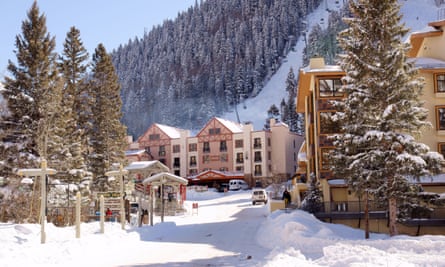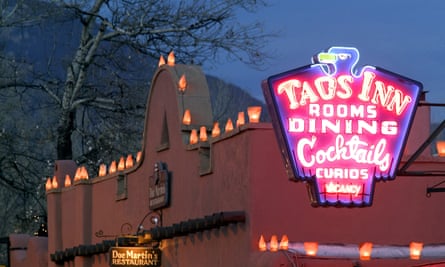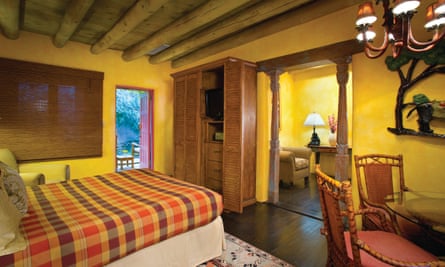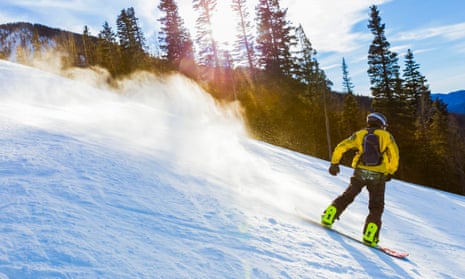In the biting cold of the dark, incense-scented St Jerome chapel, tour guide Francisco Velarde, or “Flying Hawk” in his native Tiwa language, is explaining his people’s history to a small audience of tourists huddled in pews in their ski jackets. His ancestors, the “red willow people”, have lived here in Taos Pueblo for 1,000 years, he says, making it one of the oldest continuously inhabited communities in the US; an unusually successful revolt made them the only tribe to never be displaced on to a reservation. It’s a fascinating history, especially from the mouth of this passionate, streetwise student, part of Native American hiphop group Po.10.Cee, which has 27 albums to its name.
The Guardian’s product and service reviews are independent and are in no way influenced by any advertiser or commercial initiative. We will earn a commission from the retailer if you buy something through an affiliate link. Learn more.
As he leads us between the apricot-hued multi-storied adobe buildings – crafted, he says, from “nothing but dirt, water and straw”, he points out the square that hosts dances and greased-pole climbing competitions, and takes us inside shadowy rooms thick with wood smoke, where local artists have created tiny galleries and craft shops. I buy a white carved stone bear to fit in my palm and bring me luck.

The mountains may be as steep as the Alps, and the snow as deep, but in Taos, New Mexico’s premier ski town, the après-ski is rather different – and with Native Americans increasingly sidelined in Trump’s America, it’s a chance to support their communities.
Skiers have been drawn across the plains to the Sangro de Cristo mountains since the 1950s. After spotting the incredible snow basin while flying his Cessna between two other ski resorts he managed, Ernie Blake, his wife Rhoda and their three kids, developed and ran the resort from its opening in 1955 until it was bought by hedge-fund billionaire Louis Bacon in 2013.

Taos is smarter and more built up now, but its steep, unpisted gullies and powder chutes remain the big sell, though these are easier to reach thanks to a new chairlift added in 2014, up the 3,804-metre Kachina Peak, previously accessed only via a 45-minute hike.
The flipside of visiting during the early season sweet spot (after Thanksgiving but before Christmas), when prices are reduced, means the snow gods weren’t in my favour – it was too scant to attempt the steep stuff. But the forested lower flanks’ 110 pistes offered sufficient fun and variation to fill a few days, and prove Taos isn’t just an experts’ resort.

What really recommends it to all sorts of skiers, however, alongside Taos Pueblo, is downtown Taos: laid-back, quirky, full of independent shops and businesses. Here, even Walmart is an adobe-style building, but I prefer the clothes, craft and Native American stores around Taos Plaza. I buy a 1930s picture at Kimosabe, and a thick woollen poncho in Taos Adobe Quilting. My hotel, El Monte Sagrado, is decorated in true ranch style – even the bedspreads are fringed suede. Nightly live bands at the Historic Taos Inn, dubbed “the living room of Taos”, bring out locals to wish each other “happy holidays”, while at the Bent Street Cafe, I learn that in New Mexico, when you want both red and green chilli sauce with your meal, you ask for “Christmas”.
Skiing and snowboarding in Taos are wonderful, but ski trips to the US only really make sense to me combined with a road trip, and my secondary agenda, shopping for Native American crafts, informs my choice of route, a 10-day loop flying into and out of Phoenix. I first stay a night in Tucson, then hide away at the deliciously remote Casitas de Gila Guesthouse, near the 3.3 million-acre Gila national forest, to hike dry creeks and stargaze.

I hunt vintage in the wild west hippy town of Silver City, then take a heart-swelling route north, passing ranches, red rock canyons and barren escarpments. Under a fuchsia sunset, I drive on to the Zuni Reservation, New Mexico’s largest pueblo (village), where 80% of the workforce are artists and provide ripe pickings in the shops. Collecting my key for the community-run Inn at Halona from the grocery store, I queue beside families buying supplies for that week’s winter solstice celebrations – “our New Year’s Eve” they say.
The inn is stuffed to the rafters with folk art, with flowery shawls pinned to the walls. I buy gifts galore at the Zuni Craftsmen Co-Op: $20 to $30 turquoise earrings and rings – a bargain compared with what’s on sale at the numerous Native stores and galleries I discover next in Santa Fe.

While supporting these communities by buying their crafts feels more of an upfront exchange than attempting to have some sort of romanticised “Native American tourism experience”, the pueblos protect their culture well, admitting tourists only on their terms, closing frequently for ceremonies or private events; often I follow “open” signs miles down lanes to other pueblos, only to find their museums and shops all shut up.
“Tourists’ first question is always, what time is the dancing?” laments Richard Mermejo, a member of the Picuris Pueblo, as we drink coffee in the upmarket Hotel Santa Fe, in which his tribe is a business partner, and which displays incredibly fine examples of Native American work. But dances are not shows with a set start time, he explains; they happen when everyone’s ready. “You’re not coming to an attraction [when you visit a pueblo], you’re coming to share in a living experience.”

Taos itself is home to the most accessible of New Mexico’s 19 pueblos. There are tours every 20 minutes, and tourists have been admitted since 1963. “Some of the older people are still mad about that,” laughs Francisco. But he adds: “No one will ever be allowed to see the most sacred events … we don’t spill the beans about what we really do here.”
Visitors can come away with a little insight, with gifts and treasure, but it’s nothing they don’t want us to have.

Comments (…)
Sign in or create your Guardian account to join the discussion